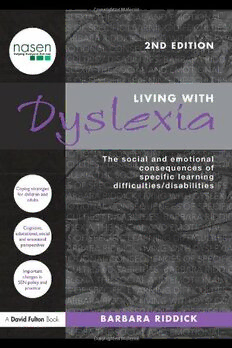
Living With Dyslexia: The social and emotional consequences of specific learning difficulties disabilities, 2nd Edition (David Fulton Nasen) PDF
240 Pages·2009·1.823 MB·English
Most books are stored in the elastic cloud where traffic is expensive. For this reason, we have a limit on daily download.
Preview Living With Dyslexia: The social and emotional consequences of specific learning difficulties disabilities, 2nd Edition (David Fulton Nasen)
Description:
This book reinforces the need for understanding and support for childrenwith dyslexia from parents and teachers, but also the importance of thechildren's own understanding of their strengths and weaknesses in orderto fulfil their potential. It should be recommended reading for allthose involved in dyslexia. - Professor Angela Fawcett, Director of the Centre for Child Research, Swansea University What is it like living with dyslexia on a day-to-day basis? Based on interviews with dyslexic children and their families, this insightful book presents first-hand accounts of how dyslexia affects the children themselves and the people around them. Living with Dyslexia, Second Edition places the original fascinating findings within the context of current research and practice in the UK, Europe, Australia and the USA. The author: examines issues of confidence and self-esteem; explores the coping strategies adopted by children and adults with dyslexia; investigates the concept of dyslexia-friendly schools; studies how children were first identified as having dyslexia, and the social and emotional difficulties they encountered; offers guidance on how teachers and parents can best support children with specific learning difficulties; considers the cognitive, educational, social and emotional perspectives in order for teachers and parents to gain a better understanding of dyslexia. This new edition provides an updated account of cognitive research and examines important changes in relation to Special Educational Needs policy and practice in the last ten years, including the Revised SEN Code of Practice (2001), Removing Barriers to Achievement (2004) and the National Literacy Strategy (2006). Living with Dyslexia recognises that the voices of children with dyslexia are increasingly important in developing good educational practice and makes an important contribution to the literature on dyslexia.
See more
The list of books you might like
Most books are stored in the elastic cloud where traffic is expensive. For this reason, we have a limit on daily download.
